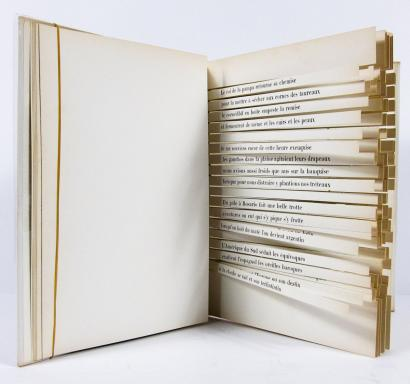Cent Mille Milliards de poèmes (A Hundred Thousand Billion Poems, in English)
This book is composed of ten sonnets, each line being printed on a separate strip of paper, allowing the reader, by freely combining the different lines, to potentially produce and read a hundred thousand billion different sonnets.

Comp Scientist Dimitri Starykevitch, made an early attempt at transposition of the book to a computer.
We wished that M. Starynkevitch would explain the method used; we hoped that the choice of the verses was not left to randomness
in the process that would make it possible to generate poetry indefinitely and automatically, which may seem surprising at first glance.
NOTE
Interaction is part of the experience. Feeling the strips of paper and putting them into desired positions.
While this is possible, we also think that the main goal of Queneau was not just to produce an infinite number of poems generated randomly. The book, with its strips of paper, is in fact more than a book, it is also a piece of art and an object conceived as a device to be manipulated by people. The whole idea is to assemble lines of verse, look at the result, try other possibilities and produce silly, funny, or just unexpected poems
Uncreative Writing challenges conventional notions of creativity and authorship in the realm of literature. Goldsmith’s approach advocates for a departure from the traditional, romanticized image of the writer as a solitary genius crafting original, imaginative works. Instead, he promotes the idea that creativity can also be found in the act of appropriation and remixing, where writers repurpose existing texts, often without significant alteration, to create something new and thought-provoking.
Transform written texts into a phonetic transcription, then transform phonetic transcription into a representation that corresponds with French versification rules.
To do this, we made a simple device that allows a user to generate a poem automatically by turning a crank. This device, which is both mechanical and electronic, is a direct reference to Hans Haacke’s Condensation Cube,
CONDENSATION CUBE - Hans Haacke
‘…The conditions are comparable to a living organism which reacts in a flexible manner to its surroundings. The image of condensation cannot be precisely predicted. It is changing freely, bound only by statistical limits. I like this freedom.’ Museum conservators monitor the cube for fungal growth. If any hint of fungal growth is identified, the artwork is drained, cleaned and sterilized. Then new, sterilized water is added back into the cube through a tiny hole with a pipette. The artwork is resealed tightly with a screw plug roughly the size of lentil.
Objections
By assembling lines of verse selected from different poems (either randomly or with the light supervision of the reader) one may often produce meaningless texts. This could lead the reader to think that poetry can be anything, that even meaningless text or just a bunch of random words put together can be poetry. In brief, people could lose the sense of what real poetry is.
Line search:
As Hartman suggests, the reader’s imagination is challenged, as it is nearly always possible to find some meaning, draw some connexions and interpret combined verses. At the same time, our experiments showed that the application is also a strong incentive to rediscover poetry: very often, people are intrigued by a line and want to go back to the original poem.